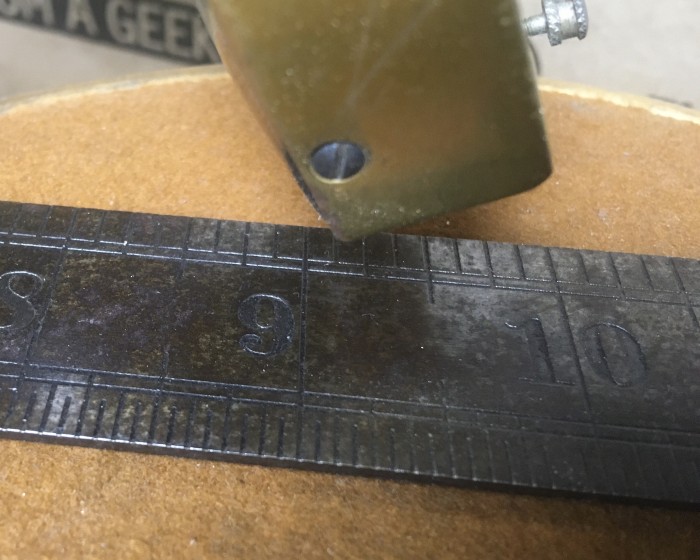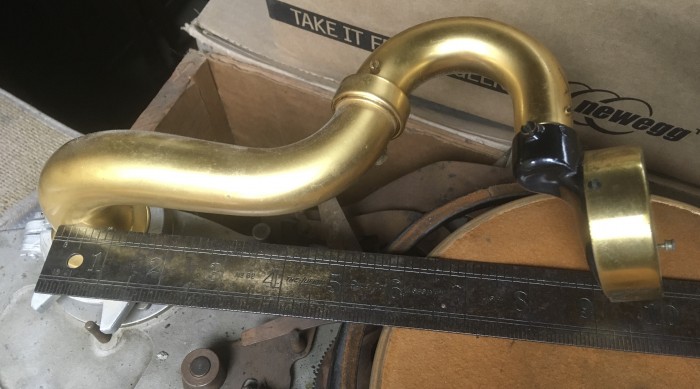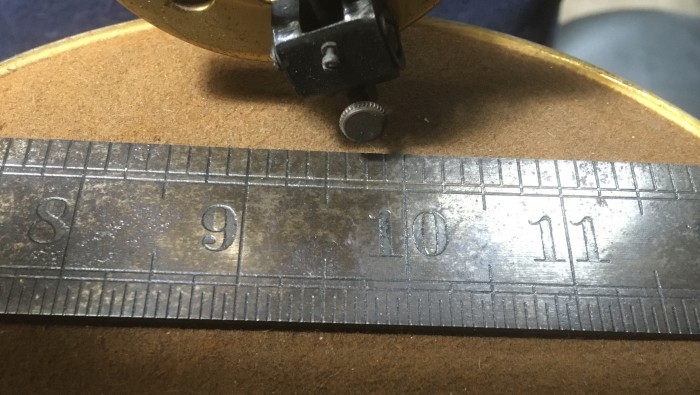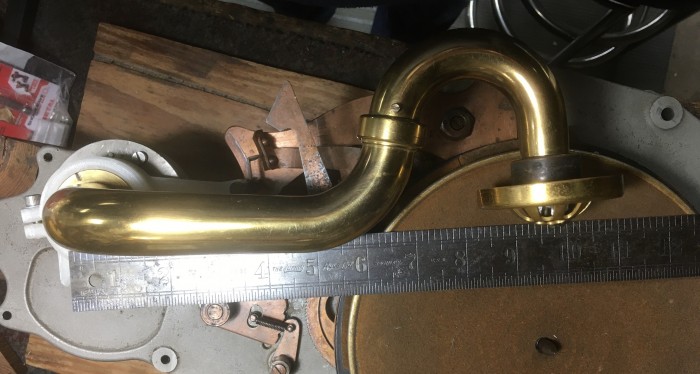Page 1 of 1
Electrola tone arm
Posted: Sat Mar 26, 2022 11:48 pm
by streetmechanic14
I understand two different tone arms were used on the 1927 Victor record changer, the acoustic version using a slightly longer arm than the electrical pickup version. Can anyone give me the dimensions of the electric version?
-Dave
Re: Electrola tone arm
Posted: Thu Mar 31, 2022 5:26 pm
by MarkELynch
Dave,
Yes, both the tonearm and the tonearm return lever are different between the Orthophonic (10-50) and the Electrola (9-55, 10-51, 10-70) versions of the first style (1927) changer.
It is a bit hard to measure but maybe these photos will help. Measured from the center of the tone arm base to the needle there is about a half-inch different in length. The arm length for the Electrola needs to be shorter because of the shape of the electrical pickup versus the Orthophonic soundbox.
Electrola:

- Electrola

- Electrola
Orthophonic:

- Orthophonic

- Orthophonic
I hope you find the right parts for your 10-51. What shape is the moving coil driver in? Most are badly swollen and not useable. Keep us posted on your progress.
Mark
Re: Electrola tone arm
Posted: Thu Mar 31, 2022 8:53 pm
by streetmechanic14
Mark-
Thanks for the great pictures. Just one more question- Is it the back ("taper tube") portion of the arm that's shorter or are both the front and back sections different on the electric and acoustic machines?
-Dave
Re: Electrola tone arm
Posted: Sat Apr 02, 2022 3:46 pm
by streetmechanic14
Mark-
Sorry for the abbreviated response to your reply, TMF's messaging was feeling "on'ry" yesterday and ate a couple of my attempts to be more talkative.
I have two drivers, one so bad (including, sadly, a corroded diaphragm) it can never be anything but parts, the other much better cosmetically but still too swollen to be used as is. I'm hoping to use the metal gasket rings from the junker to make a properly circular platform in the distorted casting for the good diaphragm to rest on. The only real requirement (I tell myself encouragingly) is an airtight seal from the top surface of the diaphragm to the horn throat. Seems do-able but we'll see.
Interestingly one of the drivers (I don't remember which) came not from another 10-51 but from a late-production 9-40.
-Dave
Re: Electrola tone arm
Posted: Sat Apr 02, 2022 5:02 pm
by MarkELynch
Dave,
Thanks for your reply about the driver in your 10-51, I hope you are able to make one work, the potmetal casting is a real problem with those. The Victor literature referred the large driver as a “moving coil type loud speaker”, “intermediate speaker”, and the “8-60 Adjustment” and “9-40 Adjustment” The voice coil was wound on an aluminum form and attached to the center of a large pleated Orthophonic type diaphragm. Here is a shot of one of mine.
I have a 9-40 that was “adjusted” to use the moving coil driver. in addition to the driver, the output transformer in the Tomcat amp needed to be changed to match. I believe that mine was done by Victor before leaving the factory because the service instruction label pasted inside the back panels shows the large driver. When looking more closely I realized that the label was carefully pasted over the previous label which likely shows the magnetic driver.
Here is an interesting tidbit:
This appears in the Victor Management Committee Meeting Minutes now housed at the Hagley museum. It documents the decision and the expenditure to convert the machines over to the large driver in April 1928. What happened to those 2000 drivers? Hopefully at least a few are useable! $40,000 to convert all the 8-60’s and 9-40’s on hand and with the trade without cost was quite a commitment.
Mark
Re: Electrola tone arm
Posted: Sun Apr 03, 2022 7:37 pm
by streetmechanic14
Mark-
The meeting minutes are fascinating and tell me I had a mistaken idea when I assumed Victor simply had a large left-over stock of moving coil drivers as a result of the 10-51's poor sales. To order 2000 more shows a real commitment to the moving-coil principle; makes me all the more curious about what it actually sounded like. I wonder, too, how significant is the rather off-hand mention of the 8-60. I've heard of the existence of a number of the "revised" 9-40's but I can't remember anyone's reporting a moving-coil 8-60. Their use of words is odd too... "Intermediate unit" . Intermediate between what I wonder?
Finding a good "un-swollen" driver would have seemed to me highly unlikely before a recent conversation with Chuck A. told me of an 8-60 with a good original valve gear. After that I have to conclude that any Victor pot-metal part may occasionally turn up in good shape.
Pardon the digression but I wonder whether this 1928 decision by Victor was part of a growing belief that the "balanced-armature" magnetic principle would never meet the demand for more faithful reproduction of music. When, in an earlier post, I asked about how Victor(and Brunswick) arrived at their model line-up I was hoping somebody would have precise info about things like this- exactly what, exactly when, and possibly why.
-Dave
Re: Electrola tone arm
Posted: Mon Apr 04, 2022 1:10 pm
by Skihawx
I think if the order for 2,000 really went thru there would be a lot more 8-60's and 9-40's with this driver. The number I have seen or heard of is way too small. My guess is that only a few were updated. These were not great sellers. Several hundred completed VE 8-60's were stripped of the tone arm and amplifier and sold as a model VE 8-30-S. The pilot light on the bottom front was plugged with wood. The compartment light remained however the volume control and on off switch were removed. The ID tag was moved off the back rail to cover an unused hole. Even the decal in the lid was spliced to change "Electrola" to "Victrola". The horn valve and driver could then connect to period radio.
Re: Electrola tone arm
Posted: Mon Apr 04, 2022 8:49 pm
by streetmechanic14
Skihawx-
Sorry to belabor this but has anyone reported actually seeing a moving-coil 8-60? Just curious. You're probably right about how unlikely it is that 2000 moving-coil 9-40's were produced (the machine was pretty long in the tooth by April '28) but I have heard of a number of them in collections and have seen (and benefited from) the remains of one myself.
Just in case some Orthophonic folks don't know what we're talking about I'm attaching pictures of the moving-coil diaphragm next to a conventional Orthophonic sound box one.
-Dave
Re: Electrola tone arm
Posted: Tue Apr 05, 2022 11:25 am
by MarkELynch
Dave and Jeff,
Thanks for the additional information, photos and insights!
Apparently there was some issue with selling the remaining 10-51’s and Victor thought that changing the diaphragm would help. The meeting notes do not describe the issue other than that the model was obsolete and would soon be replaced, they just refer to the “10-51 Situation” Apparently an alternate diaphragm was designed and was being tested but they decided to close out the remaining 10-51’s as-is at a discount. They don’t describe a defect in the existing diaphragm. Perhaps the committee thought that they would be easier to sell if the diaphragm were replaced. Maybe this was to make it compete with the replacement, the 10-69 which was cheaper.
Notice from the production schedule that there were two different cabinet finishes. “Full Body Finish” which probably means a glossy lacquer and “Open Grain Flat Finish”, the list price on the flat finish was $75 less. I’ve seen this flat finish on 10-50’s and other models.
Again from the meeting notes:
Re: Electrola tone arm
Posted: Wed Apr 06, 2022 11:49 pm
by streetmechanic14
Mark-
The diaphragm change is puzzling. I wonder if the first design was found incapable of standing up to the 1928 (26 and 50) amplifier; after all the original design apparently served well enough to work with what was likely the lion's share of 10-51 production with their tomcat amps. Since the diaphragm in my picture came from a 9-40 there is at least a possibility it is the later design. The update might have been very subtle- maybe involving only the gauge of duralumin (sp?) used. I went looking for the other (corroded) diaphragm I have for a comparison but it is eluding me at the moment. This was almost certainly the early design since the 10-51 it came out of has a serial number in the low 500's.
-Dave